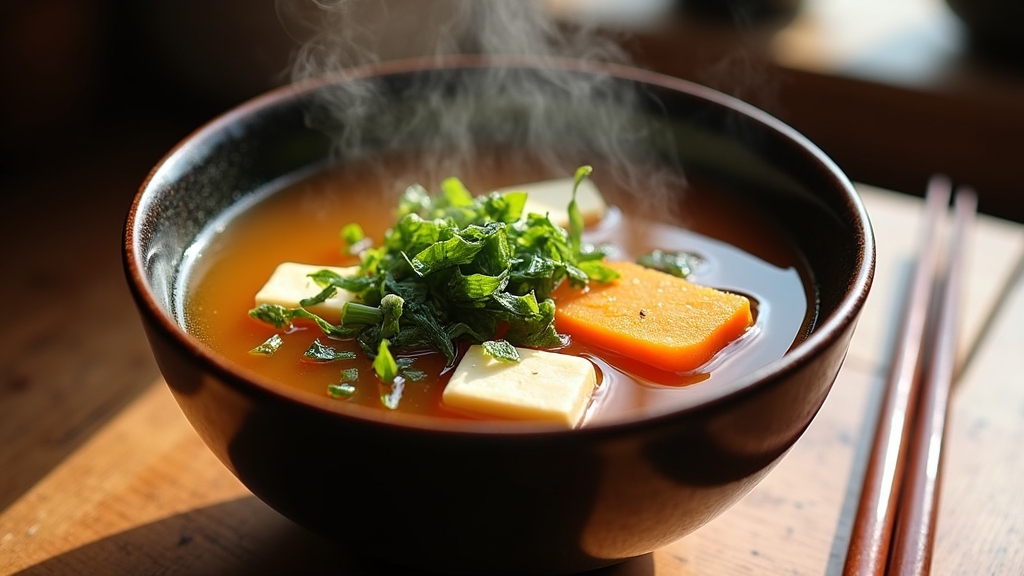If you’re looking to make a comforting bowl of miso soup, I’ve got you covered! Start with high-quality miso paste, fresh tofu, and seasonal veggies. Simmer dashi stock, then dissolve the miso in warm stock before blending it all together. Finish with green onions and seaweed for added flavor and texture. This delicious soup isn’t just nourishing; it’s packed with probiotics and rich in culture. Stick around, and I’ll share even more tips for this delightful dish!
History
When I explore the history of miso soup, I find it fascinating how this simple dish reflects Japan’s cultural evolution. Originating over a thousand years ago, miso soup has roots deeply embedded in Japanese cuisine, showcasing the country’s agricultural practices and culinary ingenuity. Initially a luxury for the elite, it gradually became a staple for all, symbolizing unity and comfort. The cultural significance of miso soup extends beyond mere nourishment; it embodies the Japanese philosophy of harmony with nature, as each ingredient is selected for both flavor and health benefits. Today, as I sip this savory broth, I appreciate not just its taste, but also the rich traditions that have shaped it, making it an innovative bridge between past and present.
Recipe
Miso soup is a traditional Japanese dish that is known for its comforting warmth and rich umami flavor. This delightful soup is simple to prepare and can be enjoyed as a starter or a light meal. The main ingredient, miso paste, is fermented soybean paste that comes in various types, such as white, yellow, and red, each imparting a unique taste to the soup. Whether you prefer a lighter or stronger flavor, miso soup can be easily customized to suit your palate.
In addition to miso paste, the soup is typically made with dashi, a Japanese stock that adds depth to the dish. You can create your own dashi from scratch using kombu (dried kelp) and bonito flakes, or you can use instant dashi granules for convenience. Miso soup often includes tofu, seaweed, and green onions, but feel free to experiment by adding other vegetables or proteins to enhance the nutrition and flavor of your soup.
Ingredients:
- 4 cups water
- 1 piece kombu (about 4 inches)
- 1/2 cup bonito flakes (optional)
- 1/4 cup miso paste (white or yellow)
- 1 cup soft or silken tofu, cubed
- 1/4 cup dried wakame seaweed
- 2 green onions, sliced
To prepare the soup, begin by making the dashi. In a medium pot, combine the water and kombu, and let it soak for about 30 minutes. After soaking, bring the water to a simmer over medium heat. Just before it starts boiling, remove the kombu and add the bonito flakes, if using. Allow the mixture to simmer for about 5 minutes, then strain the dashi to remove the flakes. Return the dashi to the pot, and over low heat, dissolve the miso paste in a small bowl with a few tablespoons of the warm dashi before adding it back to the pot. Add the cubed tofu and wakame and heat gently for a few minutes. Finally, stir in the sliced green onions before serving.
When cooking miso soup, it’s important to avoid boiling the soup after adding the miso paste, as this can diminish its flavor and health benefits. Additionally, feel free to customize your soup by incorporating seasonal vegetables like mushrooms, spinach, or carrots for added texture and nutrition. For a heartier version, consider adding cooked noodles or rice. Enjoy your homemade miso soup as a nourishing dish that warms both body and soul!
Cooking Steps
Now that we’ve gathered all the ingredients, it’s time to bring our miso soup to life. I’ll guide you through each step, starting with adding dashi stock to the pot and gradually mixing in the miso paste. Together, we’ll incorporate the tofu and seaweed, adjusting the seasoning to make it just right.
Step 1. Gather All Ingredients
Before diving into the cooking process, I like to gather all the ingredients for my miso soup to guarantee a smooth experience. I begin with high-quality miso paste, which is essential for that authentic umami flavor. For my ingredient sourcing, I explore local Asian markets or specialty stores to find the freshest tofu, seaweed, and scallions. These elements not only enhance the soup’s texture but also introduce exciting flavor variations. Don’t forget to grab some dashi stock, which serves as the flavor backbone of the dish. I also love adding seasonal vegetables like mushrooms or bok choy to elevate the taste. With everything laid out, I feel ready to create a delightful bowl of miso soup that inspires culinary creativity!
Step 2. Add Dashi Stock to Pot
Three cups of dashi stock is all it takes to kick off the heart of my miso soup. I love using kombu dashi for its umami richness, but you can also explore bonito or shiitake dashi types for unique flavors. As I pour the stock into the pot, the aromas start to dance, promising a comforting bowl ahead. This stock isn’t just a base; it’s a powerhouse packed with nutrients and depth, elevating my soup to new heights. The benefits of dashi extend beyond taste—it’s a quick way to infuse layers of flavor without heavy ingredients. I let the stock simmer, coaxing out every essence, setting the stage for the next delightful step in my miso soup journey.
Step 3. Add Miso Paste Gradually
As the dashi stock simmers gently, I reach for the miso paste, enthusiastic to add its rich, savory depth to the pot. I grab a spoonful of white miso first, its delicate sweetness promising a light, creamy texture. Slowly, I dissolve it in a small bowl of warm dashi, watching it swirl and blend. Next, I consider the boldness of red miso, perfect for a deeper umami punch. I add it gradually, tasting as I go, allowing the flavors to harmonize. Each miso variety brings its own unique flavor profile, transforming the broth into a canvas of taste. This careful addition guarantees the miso’s nuances shine, creating a perfectly balanced soup that’s both comforting and innovative.
Step 4. Incorporate Tofu and Seaweed
With the miso perfectly blended into the dashi, it’s time to elevate the soup by incorporating tofu and seaweed. I love using silken tofu for its creamy texture, which absorbs the flavors beautifully and adds a protein boost—one of the many tofu benefits. Cut the tofu into bite-sized cubes and gently add them to the pot, allowing them to warm through without breaking apart. Next, I like to experiment with different seaweed varieties, such as wakame or kombu, each bringing unique flavors and nutrients. Soak the dried seaweed in water until it expands, then toss it into the soup, letting it soften while infusing the broth with its briny essence. This combination truly transforms the dish!
Step 5. Adjust Seasoning to Taste
Once the tofu and seaweed have melded into the soup, I find it’s essential to taste and adjust the seasoning to create the perfect balance. Each person’s taste preferences are unique, so this step is vital. Here’s how I do it:
- Start with a splash of soy sauce for umami.
- Add a pinch of salt if it needs more depth.
- Consider a hint of sesame oil for richness.
- A dash of rice vinegar can brighten the flavors.
- Don’t forget a sprinkle of chili flakes if you crave heat.
Nutritional Guide
While savoring a warm bowl of miso soup, I can’t help but appreciate its nutritional benefits. Not only is it delicious, but it’s also a powerhouse of health. With a low caloric content, miso soup provides a satisfying meal without the guilt. It’s rich in probiotics, aiding digestion and boosting the immune system.
Here’s a quick nutritional guide:
| Nutrient | Amount per Cup | Health Benefits |
|---|---|---|
| Calories | 40 | Low-calorie option for weight control |
| Protein | 3g | Supports muscle health |
| Fiber | 1g | Promotes digestive health |
Incorporating miso soup into your diet can be a delightful way to explore innovative health benefits while enjoying a comforting dish.
Final Thoughts
As I reflect on the simple yet profound delight of miso soup, it becomes clear that this dish isn’t just a meal; it’s an experience. The versatility of miso soup allows for endless creativity, inviting us to explore various soup variations that cater to our personal tastes. Here are a few serving suggestions to elevate your miso soup experience:
- Add tofu or tempeh for protein.
- Include seasonal vegetables like bok choy or mushrooms.
- Experiment with different types of miso, like white or red.
- Top with green onions or seaweed for extra flavor.
- Pair it with sushi or rice for a complete meal.
Embrace the warmth and comfort of miso soup, and let it inspire your culinary journey!
Frequently Asked Questions
Can I Use Instant Miso Paste Instead of Traditional Miso?
Absolutely, I’ve found instant miso paste’s convenience quite appealing! While it lacks some depth compared to traditional miso, its instant miso benefits make it a fantastic alternative for quick meals, especially when time’s tight.
What Are Common Variations of Miso Soup?
Mouthwatering miso mixes can vary wildly! I often experiment with miso types like red or white, adding ingredient substitutions like tofu, seaweed, or even mushrooms. Each bowl brings a new, exciting experience to savor!
How Long Can Miso Soup Be Stored in the Fridge?
I’ve found that miso soup can last about three to five days in the fridge. Proper soup storage in an airtight container helps maintain miso longevity, ensuring it remains delicious for your next craving!
Is Miso Soup Gluten-Free?
Is miso soup gluten-free? It can be, but I always check the miso alternatives for gluten sources. Some brands use barley, while others don’t. I love discovering new gluten-free options to enhance my meals!
Can I Freeze Miso Soup for Later Use?
I’ve found that freezing miso soup works well using simple freezing techniques. Just store it in airtight containers to maintain flavor. Thaw it gradually for a delightful, warm bowl anytime, making miso storage a breeze!
Conclusion
As I sip my comforting bowl of miso soup, I’m reminded that this humble dish has nourished Japanese families for over a thousand years. Did you know that approximately 60% of Japanese people enjoy miso soup daily? It’s not just a meal; it’s a warm hug in a bowl, rich in flavor and history. So, whether you’re new to cooking or a seasoned chef, I hope you’ll embrace this recipe and make it your own!

Miso Soup Recipe
Ingredients
Equipment
Method
- Rehydrate wakame in cold water for 5 mins, then drain.
- Cube tofu and slice green onions.
- In a saucepan, heat water (or dashi) until steaming (not boiling).
- Ladle ½ cup hot broth into a bowl, whisk in miso until smooth. Return to pot.
- Gently stir in tofu and wakame. Simmer 2-3 mins (do not boil).
- Turn off heat, add green onions.
- Optional: Drizzle soy sauce. Serve immediately.
Notes
- Miso Varieties: White miso is sweeter; red miso is bolder.
- Add-Ins: Try mushrooms, spinach, or clams.
- Storage: Best fresh; refrigerate up to 2 days (reheat gently).

